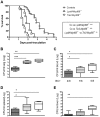Hematopoietic but not endothelial cell MyD88 contributes to host defense during gram-negative pneumonia derived sepsis
- PMID: 25254554
- PMCID: PMC4177915
- DOI: 10.1371/journal.ppat.1004368
Hematopoietic but not endothelial cell MyD88 contributes to host defense during gram-negative pneumonia derived sepsis
Abstract
Klebsiella pneumoniae is an important cause of sepsis. The common Toll-like receptor adapter myeloid differentiation primary response gene (MyD)88 is crucial for host defense against Klebsiella. Here we investigated the role of MyD88 in myeloid and endothelial cells during Klebsiella pneumosepsis. Mice deficient for MyD88 in myeloid (LysM-Myd88(-/-)) and myeloid plus endothelial (Tie2-Myd88(-/-)) cells showed enhanced lethality and bacterial growth. Tie2-Myd88(-/-) mice reconstituted with control bone marrow, representing mice with a selective MyD88 deficiency in endothelial cells, showed an unremarkable antibacterial defense. Myeloid or endothelial cell MyD88 deficiency did not impact on lung pathology or distant organ injury during late stage sepsis, while LysM-Myd88(-/-) mice demonstrated a strongly attenuated inflammatory response in the airways early after infection. These data suggest that myeloid but not endothelial MyD88 is important for host defense during gram-negative pneumonia derived sepsis.
Conflict of interest statement
The authors have declared that no competing interests exist.
Figures






Similar articles
-
The role of platelet MyD88 in host response during gram-negative sepsis.J Thromb Haemost. 2015 Sep;13(9):1709-20. doi: 10.1111/jth.13048. Epub 2015 Aug 6. J Thromb Haemost. 2015. PMID: 26178922
-
Platelet and endothelial cell P-selectin are required for host defense against Klebsiella pneumoniae-induced pneumosepsis.J Thromb Haemost. 2015 Jun;13(6):1128-38. doi: 10.1111/jth.12893. Epub 2015 Apr 23. J Thromb Haemost. 2015. PMID: 25773400
-
Thrombocytopenia impairs host defense in gram-negative pneumonia-derived sepsis in mice.Blood. 2014 Dec 11;124(25):3781-90. doi: 10.1182/blood-2014-05-573915. Epub 2014 Oct 9. Blood. 2014. PMID: 25301709 Free PMC article.
-
The innate immune rheostat: influence on lung inflammatory disease and secondary bacterial pneumonia.Biochem Soc Trans. 2009 Aug;37(Pt 4):811-3. doi: 10.1042/BST0370811. Biochem Soc Trans. 2009. PMID: 19614599 Review.
-
Therapeutic strategies in pneumonia: going beyond antibiotics.Eur Respir Rev. 2015 Sep;24(137):516-24. doi: 10.1183/16000617.0034-2015. Eur Respir Rev. 2015. PMID: 26324814 Free PMC article. Review.
Cited by
-
Endoplasmic reticulum chaperone gp96 in macrophages is essential for protective immunity during Gram-negative pneumonia.J Pathol. 2016 Jan;238(1):74-84. doi: 10.1002/path.4637. Epub 2015 Oct 19. J Pathol. 2016. PMID: 26365983 Free PMC article.
-
Tenascin C Has a Modest Protective Effect on Acute Lung Pathology during Methicillin-Resistant Staphylococcus aureus-Induced Pneumonia in Mice.Microbiol Spectr. 2021 Sep 3;9(1):e0020721. doi: 10.1128/Spectrum.00207-21. Epub 2021 Jul 28. Microbiol Spectr. 2021. PMID: 34319124 Free PMC article.
-
Hypoxia-Inducible Factor-1α in Macrophages, but Not in Neutrophils, Is Important for Host Defense during Klebsiella pneumoniae-Induced Pneumosepsis.Mediators Inflamm. 2021 Aug 5;2021:9958281. doi: 10.1155/2021/9958281. eCollection 2021. Mediators Inflamm. 2021. PMID: 34393650 Free PMC article.
-
Granzymes A and B Regulate the Local Inflammatory Response during Klebsiella pneumoniae Pneumonia.J Innate Immun. 2016;8(3):258-68. doi: 10.1159/000443401. Epub 2016 Feb 20. J Innate Immun. 2016. PMID: 26894590 Free PMC article.
-
Role of Myeloid Tet Methylcytosine Dioxygenase 2 in Pulmonary and Peritoneal Inflammation Induced by Lipopolysaccharide and Peritonitis Induced by Escherichia coli.Cells. 2021 Dec 28;11(1):82. doi: 10.3390/cells11010082. Cells. 2021. PMID: 35011643 Free PMC article.
References
-
- World Health Organisation (2012) WHO causes of death 2008, Global health Observatory, World Health Organisation.
-
- Kollef MH, Shorr A, Tabak YP, Gupta V, Liu LZ, et al. (2005) Epidemiology and outcomes of health-care-associated pneumonia: results from a large US database of culture-positive pneumonia. Chest 128: 3854–3862. - PubMed
-
- Coque TM, Baquero F, Canton R (2008) Increasing prevalence of ESBL-producing Enterobacteriaceae in Europe. Euro Surveill 13 19044. - PubMed
Publication types
MeSH terms
Substances
LinkOut - more resources
Full Text Sources
Other Literature Sources
Medical
Molecular Biology Databases
Miscellaneous

